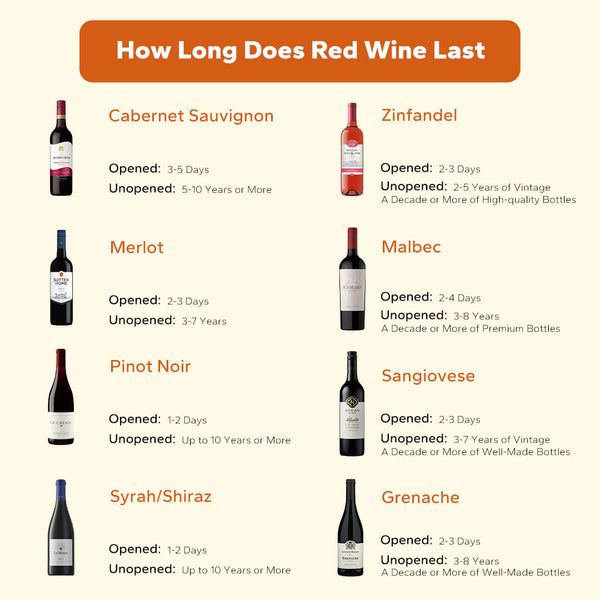How long does red wine last? In general, unopened bottles of red wine can last for several years, often improving with age. However, once opened, red wine typically remains at its best for about 3-5 days if stored properly. Throughout this piece, we'll go into more detail about the things that affect how long red wine lasts and give you useful tips on how to get the most out of it.
What Affects the Shelf Life of Red Wine?
Storage Conditions
The best way to keep red wine's quality is to store it correctly. Red wine should be kept in a cool, dark place where the temperature and humidity stay the same. Heat, light, and changes in temperature can speed up the aging process and make the wine go bad before it's time.
Type of Wine
There are different amounts of acidity, tannins, and alcohol in different types of red wine, which can affect how long they last. Cabernet Sauvignon and Syrah, which are full-bodied red wines with high tannin levels, tend to age well and last longer than Pinot Noir and Merlot, which are lighter-bodied wines.
Storage Position
The way red wine bottles are kept can also change how long they last. It's important to store wine bottles on their sides so that the cork stays wet and doesn't dry out, which could cause the wine to go bad too soon.
Bottle Closure
The type of cap that is on the wine bottle can also affect how long it will last. Wines that are sealed with natural cork let a little air in, which can speed up the aging process and make the wine more complex over time. On the other hand, wines that are sealed with fake corks or screw caps may not last as long but are better at keeping the flavor from oxidizing.
Age of the Wine
Most of the time, older red wines have already been aged and matured, which can make their flavors more rich and help them last longer. But not all red wines are meant to be aged for a long time. Some are better when they are young and fresh.
Shelf Life of Red Wine by Varietal

Cabernet Sauvignon
Unopened: Cabernet Sauvignon has a relatively long shelf life when unopened, typically ranging from 5-10 years or more, depending on the quality of the wine and storage conditions.
Opened: Once opened, Cabernet Sauvignon can maintain its quality for 3-5 days if stored properly in a cool, dark place with a tight seal.
Merlot
Unopened: Merlot is best consumed within 3-7 years of vintage for optimal flavor and quality.
Opened: Once opened, Merlot should be enjoyed within 2-3 days to preserve its fruity characteristics and prevent oxidation.
Pinot Noir
Unopened: Pinot Noir is typically best enjoyed within 3-5 years of vintage, although some higher-quality bottles can age gracefully for up to 10 years or more.
Opened: Once opened, Pinot Noir should be consumed within 1-2 days to retain its delicate flavors and aromas.
Syrah/Shiraz
Unopened: Syrah/Shiraz wines have a shelf life of 5-10 years or more, with some premium bottles aging well for two decades or longer.
Opened: Once opened, Syrah/Shiraz can maintain its quality for 3-5 days if stored in a cool, dark place with minimal exposure to air.
Zinfandel
Unopened: Zinfandel is best enjoyed within 2-5 years of vintage, although some high-quality bottles can age well for a decade or more.
Opened: Once opened, Zinfandel should be consumed within 2-3 days to prevent flavor loss and oxidation.
Malbec
Unopened: Malbec wines typically have a shelf life of 3-8 years, with some premium bottles capable of aging gracefully for a decade or more.
Opened: Once opened, Malbec should be enjoyed within 2-4 days to maintain its fruity characteristics and freshness.
Sangiovese
Unopened: Sangiovese wines are best consumed within 3-7 years of vintage, although some high-quality bottles from renowned producers can age well for over a decade.
Opened: Once opened, Sangiovese should be consumed within 2-3 days to prevent oxidation and preserve its lively acidity.
Grenache
Unopened: Grenache wines typically have a shelf life of 3-8 years, although some well-made bottles can age gracefully for a decade or more.
Opened: Once opened, Grenache should be enjoyed within 2-3 days to maintain its fruity flavors and prevent oxidation.
Tips for Extending the Shelf Life of Red Wine
Proper Storage
Red wine bottles that haven't been opened should be kept in a cool, dark place that stays between 55°F and 65°F (13°C to 18°C). Don't keep wine in places where the temperature can change quickly, like kitchens or near machines that make heat.
Horizontal Storage
Keep wine bottles stored horizontally as much as possible to keep the cork wet and stop it from drying out. This helps keep the seal tight and lowers the chance of air getting in, which can cause rusting to happen too soon.
Controlled Humidity
Keep the relative humidity in the area where you store your wine between 50 and 70% so that the corks don't dry out and let air into the bottle. If you want to keep wine for a long time, buy a wine fridge or cellar that can control the temperature.
Limited Light Exposure
UV rays can damage wine and make it taste bad, so keep it out of direct sunlight and strong artificial light. Put your things away from windows or buy shades or curtains that block UV light.
Gentle Handling
Be careful when handling wine bottles so that sediment doesn't get stirred up too much, especially for old red wines. When moving or storing bottles, don't shake or jostle them, because this can stop the wine from aging naturally.
Use Vacuum Sealers
Invest in vacuum sealers or wine preservation systems to remove excess air from opened wine bottles and create a vacuum seal. This helps slow down oxidation and preserves the wine's flavors and aromas for longer periods.
Refrigeration
If you can't drink a whole bottle of red wine in one sitting, put the cork or wine stopper back on top of it and put it in the wine cooler right away. Putting opened wine in the fridge slows down spoilage and adds a few days to its shelf life.
Avoid Strong Odors
Because wine can easily soak up smells through the cork, keep it away from foods, chemicals, or cleaners that have strong smells. Keep wine away from these things so that its delicate tastes and smells don't get ruined.
FAQs
Does Red Wine Go Bad?
Yes, red wine can go bad, but the timeline for spoilage depends on several factors such as storage conditions, type of wine, and whether the bottle has been opened. Properly stored unopened red wine can last for years, while opened bottles typically have a shorter shelf life, ranging from a few days to a week or more.
How Can You Tell if Red Wine Has Gone Bad?
Bad Smell: The wine has probably gone bad if it smells like vinegar, rotten eggs, or wet cardboard.
Off Taste: If you taste the wine, you can tell if it has grown bad tastes like sourness, bitterness, or a flat, dull taste.
Problems with the color: Red wine that has turned cloudy or brown could be going bad.
Presence of Sediment: If there is a lot of sediment or bits floating in the wine, it may be showing signs of aging.
Why Does Red Wine Go Bad?
Oxidation: Wine can lose its good tastes and smells when it comes into contact with air.
Microbial Contamination: Fermentation or spoiling can happen when bacteria or yeast get into wine, especially in bottles that have already been opened.
Light: Ultraviolet (UV) light can break down molecules in wine, which can change its taste, color, and smell.
Changes in Temperature: Changes in temperature, especially high temperatures, can make wine age and go bad faster.
Bad Storage: Putting wine away in places with a lot of humidity, too much heat, or strong smells can also make it go bad.









